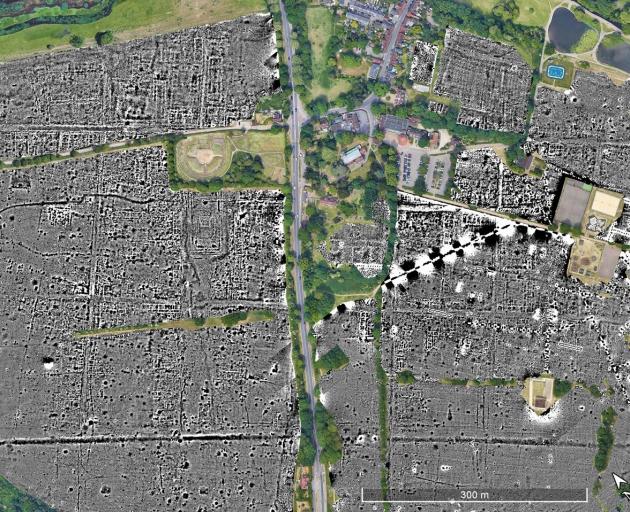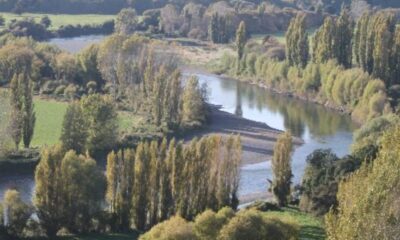Science
New Technology Reveals Hidden Secrets of Verulamium’s Past

Recent advancements in geophysical survey technology have shed new light on the ancient city of Verulamium, revealing previously hidden structures and features. The innovative use of a newly developed geophysical technique is allowing researchers to better understand the layout and history of this significant Roman settlement.
Uncovering the Past
The latest findings at Verulamium come after a long history of archaeological exploration. In an earlier project, Martin Aitken, an Oxford scientist, introduced a proton magnetometer, a device that has since become invaluable for subsurface exploration. Aitken’s initial work in the city led to the discovery of an early Roman defensive ditch, believed to have been dug hastily in response to threats from the notorious Queen Boudicca’s forces.
This groundbreaking method involved a simple setup: a bottle connected to various wires and a screen to capture electronic signals. The objective was to analyze disturbances in the ground, which could indicate the presence of ancient structures. The results were remarkable, mapping out critical features of the city’s past.
Modern Techniques Illuminate Ancient Structures
Fast forward to 2023, and the exploration of Verulamium has progressed even further with the introduction of a new geophysical survey technique. This technology is rapidly extending over the entire interior of the city, which was once fortified by stone walls. Researchers are now able to visualize the layout of streets, houses, kilns, and other significant features.
The city’s center is particularly noteworthy, containing a forum and a theatre adjacent to a large temple. The grid pattern of streets identified in the latest surveys divides the city into distinct sections, showcasing fine houses with hypocausts, bath complexes, and intricate mosaic floors. The early defensive ditch, first uncovered years ago, is now clearly visible as a dark, straight line on the updated plans.
Interestingly, one section of this ditch passes just beneath the St Alban’s first XI cricket pitch. Due to concerns about disturbing the grounds, no readings were taken in that area. Meanwhile, a sinuous dark line has been identified as the aqueduct that once supplied water to the theatre, adding another layer of understanding to the city’s infrastructure.
In earlier excavations, a stunning mosaic featuring a lion was uncovered, hinting at the treasures that may still lie beneath the surface. With advancements in technology, archaeologists are optimistic that many more significant artifacts await discovery in this ancient site.
As the research continues, Verulamium stands as a testament to the ingenuity of both past and present. The combination of historical insight and modern technology is opening doors to a deeper understanding of Roman life in Britain, enriching both academic knowledge and public interest in the region’s heritage.
-

 World1 month ago
World1 month agoTest Your Knowledge: Take the Herald’s Afternoon Quiz Today
-

 Sports1 month ago
Sports1 month agoPM Faces Backlash from Fans During Netball Trophy Ceremony
-

 Lifestyle1 month ago
Lifestyle1 month agoDunedin Designers Win Top Award at Hokonui Fashion Event
-

 Sports1 month ago
Sports1 month agoLiam Lawson Launches New Era for Racing Bulls with Strong Start
-

 Lifestyle1 month ago
Lifestyle1 month agoDisney Fan Reveals Dress Code Tips for Park Visitors
-

 Health1 month ago
Health1 month agoWalking Faster Offers Major Health Benefits for Older Adults
-

 World2 months ago
World2 months agoCoalition Forms to Preserve Māori Wards in Hawke’s Bay
-

 Politics1 month ago
Politics1 month agoScots Rally with Humor and Music to Protest Trump’s Visit
-

 Top Stories2 months ago
Top Stories2 months agoUK and India Finalize Trade Deal to Boost Economic Ties
-

 World2 months ago
World2 months agoHuntly Begins Water Pipe Flushing to Resolve Brown Water Issue
-

 Science1 month ago
Science1 month agoNew Interactive Map Reveals Wairarapa Valley’s Geological Secrets
-

 World2 months ago
World2 months agoFonterra’s Miles Hurrell Discusses Butter Prices with Minister Willis









